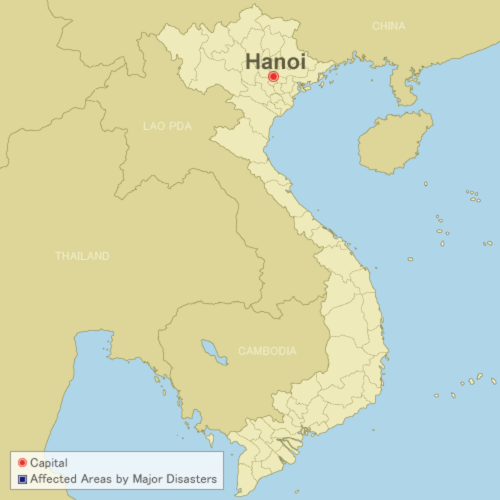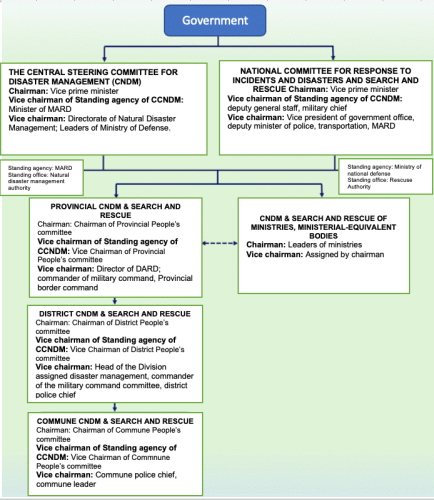TOP PAGE > Information on Disaster Risk Reduction of the Member Countries
Information on Disaster Risk Reduction of the Member Countries
 Viet Nam
Viet Nam
General Information
 Formal Name: Socialist Republic of Viet Nam
Formal Name: Socialist Republic of Viet NamVietnam is located in eastern Indochina, and borders with China, Lao, PDR and Cambodia. Vietnam comprises a total land area of 331,210 square km including 310,070 square km of land and 21,140 square km of water.
Population of Vietnam is estimated to be 97.3 million people, making it the most populous country in the Mekong region and the 16th most populous country in the world.
Vietnam recognizes 54 ethnic groups. The largest of them and their percent of the population are: Kinh (Viet) 85.3%, Tay 1.9%, Thai 1.9%, Muong 1.5%, Khmer 1.4%, Mong 1.4%, and Nung 1.1%.
One-third of total population of Vietnam lives in urban centers. The remaining two-thirds live in coastal areas and low-lying deltas. The largest urban centers are in the major cities of Ho Chi Minh City (est. 3,467,331) and Hanoi (est. 1,431,270).
Vietnam has both a tropical climate zone and a temperate climate zone, with all of the country experiencing the effects of the annual monsoon. Rainy seasons correspond to monsoon circulations, which bring heavy rainfall in the north and south from May to October, and in the central regions from September to January.
Overview of Disasters
Vietnam is one of the most hazard-prone countries in the Asia-Pacific Region. With an eastern coastline of 3,260 km the country is regularly exposed to hydro-meteorological hazards including severe storms, cyclones, typhoons, floods, landslides, and coastal erosion. About 70% of the population lives in coastal communities with high exposure to storm and flooding, which climate change is intensifying. Vietnam also faces low to moderate risks of droughts, earthquakes, tsunamis, forest fires, cold and heat waves, and zoonotic epidemics. The INFORM Global Risk Index 2022 ranks Vietnam 91 out of 191 countries for disaster risk and assigned Vietnam to a medium risk category. This ranking is based on Vietnam’s high exposure to hazards but relatively low vulnerability and above average coping capacity.
Vietnam is ranked among the five countries likely to be most affected by climate change. Extensive low-lying coastline and low-lying delta region are highly vulnerable to rising sea levels. The World Bank and ADB in their 2021 Climate Risk Country Profile of Vietnam estimate that climate change will reduce national income by up to 3.5% by 2050. The World Bank and ADB also estimate that 3-9 million people will be affected by fluvial flooding by 2035-2044 and 6-12 million people will be affected by coastal flooding by 2070-2100. While many households in Vietnam will not have the same level of exposure, climate change threatens to enhance and expand exposure through its impacts on extreme events.
Vietnam is ranked among the five countries likely to be most affected by climate change. Extensive low-lying coastline and low-lying delta region are highly vulnerable to rising sea levels. The World Bank and ADB in their 2021 Climate Risk Country Profile of Vietnam estimate that climate change will reduce national income by up to 3.5% by 2050. The World Bank and ADB also estimate that 3-9 million people will be affected by fluvial flooding by 2035-2044 and 6-12 million people will be affected by coastal flooding by 2070-2100. While many households in Vietnam will not have the same level of exposure, climate change threatens to enhance and expand exposure through its impacts on extreme events.
Recent Major Disasters
Floods and Tropical Depression (October 2021)
Floods and landslides caused by heavy rain affected northern and central Vietnam, resulting in casualties. In Quang Binh province, up to 1,903 residents across seven towns and districts were evacuated, and more than 1,300 houses were damaged. In Quang Ngai and Quang Nam at least one person died, 7,000 people were evacuated, and more than 16,400 houses were flooded. Floods and landslides blocked many of the main roads across central and north Vietnam, and power outages were reported in Thua Thien-Hue Province.
Central Vietnam Floods (October to November 2020)
In October and November 2020, Vietnam experienced the worst flooding in the past decade with the Inter Tropical Convergence Zone combined with six consecutive tropical depressions, storms, and tropical typhoons that resulted in widespread flooding in most of central Vietnam, killing 291 people with an additional 66 persons reported missing, and severely affecting 1.5 million people. The disaster destroyed over 500,000 houses, 144,000 ha of rice paddies, 787 km (489 miles) of dykes and canals, and eroded and damaged 272 km (169 miles) of coastline, resulting in economic damage worth US$1,443,850. The VNDMA reported that many areas in central Viet Nam recorded a total rainfall of more than 2,400 mm, and in some locations, floodwaters exceeded the previous historical high recorded in 1979 and 1999.
Drought (2015-2017)
The worst drought Vietnam had seen in 90 years started in 2015 and lasted until 2017. The drought was attributed to the El Niño weather event, with 52 out of 63 provinces affected. In addition, the drought was aggravated by saltwater intrusion that extended up to 90 km inland in some coastal areas, leaving river water too salty for human or animal consumption, or to irrigate crops and continue fish-farming production. In total, 2 million people including 520,000 children and 1 million women, were in need of humanitarian assistance.
Disaster Management System
Legal System
The Law No. 60/2020/QH14 on amendments to the Law on Natural Disaster Prevention and Control (LNDPC) and the Law on Dikes took effect from 1 July 2021.
Decree No. 66/2021/ND-CP
The LNDPC is supported by a series of decrees (similar in status to regulation) that supplement implementation of the law. The supporting decrees have been amended over time. The most recent decree is Decree No. 66/2021/ND-CP, effective on 28 August 2021. Decree No. 66/2021/ND-CP sets out the responsibility for news broadcasting; the allocation of responsibility and cooperation in natural disaster response; provides for disaster-related emergencies and disaster recovery; outlines the rights and obligations of foreign organizations and individuals and international organization participating in disaster response and recovery in Vietnam; and establishes benefits for communal voluntary forces in charge of natural disaster management.
Decree No. 66/2021/ND-CP
The LNDPC is supported by a series of decrees (similar in status to regulation) that supplement implementation of the law. The supporting decrees have been amended over time. The most recent decree is Decree No. 66/2021/ND-CP, effective on 28 August 2021. Decree No. 66/2021/ND-CP sets out the responsibility for news broadcasting; the allocation of responsibility and cooperation in natural disaster response; provides for disaster-related emergencies and disaster recovery; outlines the rights and obligations of foreign organizations and individuals and international organization participating in disaster response and recovery in Vietnam; and establishes benefits for communal voluntary forces in charge of natural disaster management.
Organization
 Since the enactment of the Law on Natural Disaster Prevention and Control (LNDPC) in 2013, effective 1 May 2014 and the newly updated LNDPC in 2020, Vietnam has further systematized its disaster management apparatus. The LNDPC is the first stand-alone law to set out institutional arrangements, functions, and mandates for disaster management. It is also the first law to cover all natural hazards in the country.
Since the enactment of the Law on Natural Disaster Prevention and Control (LNDPC) in 2013, effective 1 May 2014 and the newly updated LNDPC in 2020, Vietnam has further systematized its disaster management apparatus. The LNDPC is the first stand-alone law to set out institutional arrangements, functions, and mandates for disaster management. It is also the first law to cover all natural hazards in the country.The structure and responsibility for DRM and disaster response is set out in the LNDPC and its supporting decrees (regulations), which lay out a multi-agency and hierarchical model for disaster management, while also incorporating elements of Community-based Disaster Risk Management (CBDRM). The government of Vietnam coordinates its work at the national level under the umbrella of inter-ministerial committees, which are replicated at the provincial, district, and commune/ward-level. International bilateral and multilateral partners and NGOs further support the DM system of the government and coordinate their work through the mechanisms of the Disaster Risk Reduction Partnership (DRRP) and the Disaster Management Working Group (DMWG), respectively.
National Steering Committee for National Disaster Prevention and Control (NSCNDPC)
The NSCNDPC, formerly the Central Steering Committee for Disaster Prevention and Control is the top body for the DM policy development and decision-making of the government. The Standing Office of the NSCNDPC is the VNDMA, an agency under MARD. The NSCNDPC has its own seal and is granted funding for operations by the State Treasury.
Although the NSCNDPC is established under the LNDPC, its mandate and structure is further elaborated through supporting decrees (regulations) issued by the Prime Minister, which has allowed the government to refine the role and responsibilities of the NSCNDPC over time through periodic amendments.
Vietnam Disaster and Dyke Management Authority (VDDMA)
The VDDMA is the Standing Office of the NSCNDPC. From its origins ten 20 years ago as the Department of Dyke Management and Flood Control, mandate of VDDMA has widened to cover the 24 or so different types of hazards identified under the 2020 LNDPC. VDDMA serves as a natural disaster management authority year round. During the October 2020 flooding in central Vietnam, the VDDMA was as an active responder and implementer of disaster relief funds. With the government’s plans to enact a decree on the ‘Establishment and Management of Natural Disaster Prevention and Control Funds’ to be managed by VDDMA, VDDMA will have more authority to mobilize funds from domestic and international market to strengthen its role in supporting relief efforts.
Plan
The National Strategy for Natural Disaster Prevention, Response and Mitigation to 2020 was first prepared in 2007 with legal backing from the Prime Minister’s Decision No. 173/2007/QD-TTG. A draft of an updated National Strategy for Natural Disaster Prevention and Control to 2030 with and vision toward 2050 was prepared in May 2021 and is pending final approval.
ADRC Counterpart
Country Report
Country Report 2023 (English Version, PDF file)Country Report 2022 (English Version, PDF file)
Country Report 2021 (English Version, PDF file)
Country Report 2017 (English Version, PDF file)
Country Report 2006 (Japanese Version, PDF file)
Country Report 2006 (English Version, PDF file)
Country Report 1999 (English Version, PDF file)
Country Report 1999 (Japanese Version, PDF file)
Country Report 1998 (English Version, PDF file)

